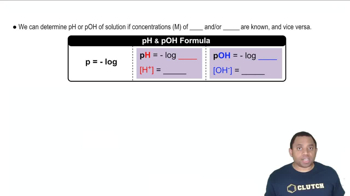Determine if each anion acts as a weak base in solution. For those anions that are basic, write an equation that shows how the anion acts as a base. a. Br– b. ClO– c. CN– d. Cl–
Ch.17 - Acids and Bases

Chapter 17, Problem 98
Determine the [OH-] and pH of a solution that is 0.250 M in HCO3⁻.
 Verified step by step guidance
Verified step by step guidance1
Identify the relevant equilibrium reaction for bicarbonate ion (HCO₃⁻) in water: HCO₃⁻ + H₂O ⇌ H₂CO₃ + OH⁻.
Write the expression for the equilibrium constant (K_b) for the reaction: K_b = [H₂CO₃][OH⁻]/[HCO₃⁻].
Use the relationship between K_w, K_a, and K_b to find K_b for HCO₃⁻: K_b = K_w / K_a, where K_w is the ion-product constant of water (1.0 x 10⁻¹⁴) and K_a is the acid dissociation constant for H₂CO₃.
Set up an ICE (Initial, Change, Equilibrium) table to determine the changes in concentration of HCO₃⁻, H₂CO₃, and OH⁻ at equilibrium.
Solve for [OH⁻] using the K_b expression and the values from the ICE table, then calculate pH using the relationship pH + pOH = 14.
Key Concepts
Here are the essential concepts you must grasp in order to answer the question correctly.
Bicarbonate Ion (HCO3⁻)
The bicarbonate ion (HCO3⁻) is a key component in the bicarbonate buffer system, which helps maintain pH in biological systems. It acts as a weak base, capable of accepting protons (H⁺) to form carbonic acid (H2CO3), thus influencing the acidity of the solution. Understanding its role is crucial for calculating hydroxide ion concentration and pH.
Recommended video:
Guided course

Ion Formation
pH and pOH Relationship
pH is a measure of the hydrogen ion concentration in a solution, while pOH measures the hydroxide ion concentration. They are related by the equation pH + pOH = 14 at 25°C. This relationship is essential for determining the pH of a solution when the concentration of hydroxide ions is known, or vice versa.
Recommended video:
Guided course

pH and pOH Calculations
Equilibrium and Acid-Base Reactions
Acid-base reactions often reach a state of equilibrium, where the rates of the forward and reverse reactions are equal. In the case of bicarbonate, it can act as both an acid and a base, depending on the conditions. Understanding how to set up and solve equilibrium expressions, such as the dissociation of HCO3⁻, is vital for calculating [OH⁻] and pH.
Recommended video:
Guided course

Acid-Base Reaction
Related Practice
Textbook Question
1
views
Textbook Question
Determine whether each anion is basic or neutral. For those anions that are basic, write an equation that shows how the anion acts as a base. c. NO3–
Textbook Question
Determine the [OH–] and pH of a solution that is 0.140 M in F–.
Textbook Question
Determine whether each cation is acidic or pH-neutral. For those cations that are acidic, write an equation that shows how the cation acts as an acid. a. NH4+
Textbook Question
Determine whether each cation is acidic or pH-neutral. For those cations that are acidic, write an equation that shows how the cation acts as an acid. b. Na+
Textbook Question
Determine whether each cation is acidic or pH-neutral. For those cations that are acidic, write an equation that shows how the cation acts as an acid. c. Co3+
